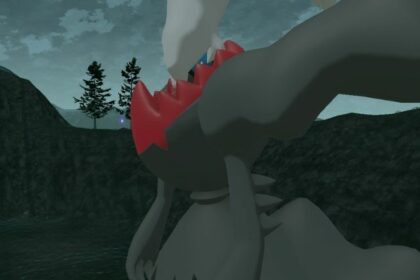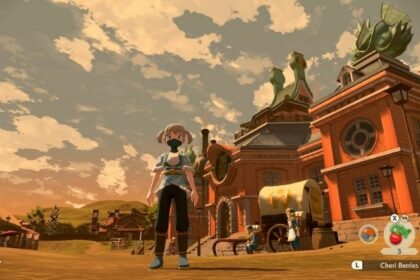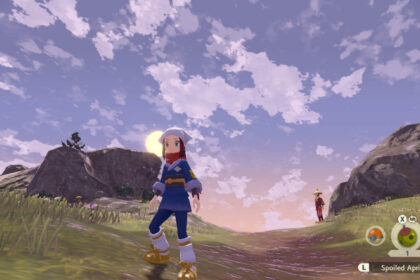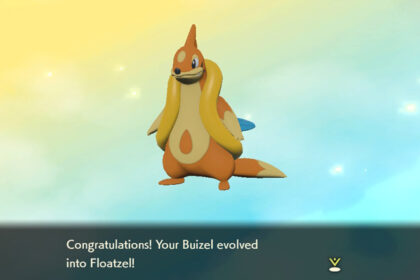Pokemon has come a long way since the monochromatic “Red and Blue” of 1996. With all the updates that we’ve had so far since then, it seemed a natural progression to get a 3D experience that actually works as it should, and allows players to interact with the game on an even deeper level.
For older Pokemon heads like myself, I can only imagine the idea of being a kid again and experiencing the game in this form. To be honest, I’m a little jealous.
Pokemon Legends: Arceus, a semi-open world Nintendo Switch game, presents the chance to explore a world filled with wild Pokemon in their natural habitats, discovering new species and training them to become the most powerful trainer in the region.
When the game was announced, I was excited about the new gameplay features and Hisui region, but I was also really hoping that Game Freak had managed to put it all together with as few kinks as possible. Especially after the slightly disappointing releases of Pokemon Brilliant Diamond and Shining Pearl, certainly not the best Pokemon remakes to date.
Anyway, for the benefit of gamers that are undecided about the value of purchasing the game, I took it upon myself to buy, test, and compile my thoughts in this detailed and honest Pokemon Legends: Arceus review. Let’s get right into it!
Graphics

It looks like there are still quite a few improvements to be made here. If you’ve played The Legend of Zelda, then you have a good idea of what the art style here is like.
That said, The Legend of Zelda still has better graphics. It’s crisper, the characters look better, and the colors are generally more vibrant. However, if we’re comparing this to previous Pokemon titles such as Sword and Shield and Brilliant Diamond, then this looks better.
Rendering is a mixed bag. In specific situations, it looks fantastic and in others, it looks like something out of a prehistoric Gamecube title. I’ll give examples.
When you’re flying, Pokemon will occasionally appear out of nowhere, which can be very distracting. Additionally, moving objects that are far away sometimes stagger and lag, and the cutscenes also need a bit of work. It all makes for a far-from-smooth experience.
On the other hand, there is some display of great graphics in certain situations like when the frenzied Pokemon emerge, or when Girantina attacks you. It shows that it is possible to implement some great design into the gameplay but for some reason, Game Freak has not managed to apply it across the game as a whole.
The scenery is the same way. Some places look great and detailed – a lot to see, basically. Some others…not so much. You can go from a scene with beautiful greenery and other attractions to a scene with rocks and sand. I mean, I guess it makes it more realistic, but this is one of the situations where fantasy would trump reality.
One area that has seen some much-needed improvement is battle animations. Before, Pokemon would just stand there, but they’re a lot more mobile and active now. Moves like Hyperbeam, Ice Beam, and Flamethrower all look pretty good.


Pokemon’s success has always been more about gameplay than graphics, so these little niggling problems may not cause any major harm to the success of this title.
However, I think the time that players begin to actively demand better graphics is closer than Nintendo and the Pokemon Company might think. After all, many other games with equally fantastic gameplay have made major improvements in that department.
Storyline
The premise of Pokemon Legends: Arceus is that the main character falls out of a space-time rift and is thrown back years into the past – a period when Pokemon were commonly owned by trainers and Sinnoh was still called Hisui.
Jubilife City is the only recognized city from the Sinnoh region, and it is the Pokemon Professor of the region that finds you and takes you back to the city. There, you have to prove your worth to the Galaxy clan by becoming a Survey Corps member and seeking out to complete the Pokedex to aid their research.

Speaking of the Pokedex, I like the extra attention that has been given to it in this title. As you run around completing the required research on as many species as possible, you get Star Ranks to mark your progression.
It’s an upgrade to the gaming experience for me because it gives me extra incentive to participate more actively instead of simply building a team strong enough to defeat any other trainer.
Anyway, there’s a lot of stuff to do on the road to returning Hisui back to its old self. You’ll meet a bunch of NPCs that actually impact how your adventure plays out, and many are based on characters in the gen 4 games. Keep an eye out for them and see how many you can figure out (Hint: Commander Kamado is a reference to Professor Rowan).
In total, there are 242 Pokemon in Hisui, and you need to catch all of them before you can catch Arceus in the post-game. It can get a bit tedious because you’ll often have to catch several of the same Pokemons just to see them use specific moves before you can increase your research level. Probably best to space out the timing instead of trying to get it all done in one go.
New features such as Mass Outbreaks and Space-Time distortions bring a new dimension to the grind aspect.
With Mass Outbreak, you get a better chance of encountering multiple Pokemons within a specific area. Chances are, you’ll find a shiny one in the process, and this happens regularly enough to keep you entertained.

Space-Time Distortions happen less frequently, which makes it more exciting when they do happen. A zone randomly pops up on the map and lasts for ten minutes while you’re playing. In the zone, you will find rare Pokemon that are even more powerful than they usually are.
There’s a lot of fun stuff here – the storyline is solid. There’s enough to keep you from getting bored even after hours of playing at a stretch, and the side quests are interesting distractions too. But again, storylines are not the most important aspect of the game for many Pokemon lovers.
Gameplay
Does this qualify as saving the best for last? I think it does.
Gameplay is the most important factor of most games in my opinion. For an RPG game with a semi-open world like this one, the attention to detail by the developers is pretty much a make or break for the success of the title.
There are five main areas to explore in Hisui. Each one has its own theme, and each one offers an array of new Pokemon to catch. The areas are all well-sized too, so you can do a fair bit of exploring in each one while you level up and unlock the others.
Click the “play” button on my video review below to see what a couple of the areas look like.
We’ve previously had to live with the restriction of specific routes in between a couple of cities, so I really like the extra room for exploration here. It makes the overall experience more engaging and reduces my need for human interaction in real life even further.
There’s a certain randomness in the process of encountering Pokemons that I like too. Unlike before, you don’t have to search in specific spots to see a random Pokemon because they’re literally all around you just chilling in their natural habitat.
I think it’s a more natural and immersive feeling encountering them like this, as it makes me feel like I’m genuinely exploring their world. I also think this upgrade is a product of the fact that the game is now being produced for the Nintendo Switch, unlike before when it was made for less capable handheld consoles.
There’s a nice little extra touch of realism in the scale of Pokemon sizes to the area that they’re found too. For instance, a Spheal on the beaches of Cobal Coastlands is suitably smaller than a massive Legendary Pokemon.
Additionally, there are more fluid options with the movement of the character itself. You can now roll away from attacks, walk around during battles, and dodge.
These extra movements are not just flashy, they actually come in handy in specific situations. For instance, if a wild Pokemon is bearing down on you, you can evade an attack more easily with the fluid movement.
If you’re feeling too cool to walk, you have alternative means of transport too – ride Pokemons. You can move more quickly across land while riding on a Wyrdeer, or fly with a Braviary.

Apart from quicker transport, you’ll also be able to explore more areas of the map this way. There are places that you just may not notice or won’t be able to reach on foot, so the option to ride brings a whole new dimension to the game.
When it comes to battles, not much has changed. The minor differences include the fact that every Pokemon now has the opportunity to master a move that they know, which will allow for them to use the move in an Agile or Strong style.
The Agile style makes them use the move quicker, while the Strong style makes them hit harder. There are more nuances involved that have to do with the specific ability of your Pokemon, but that’s the general idea.
I should mention that I noticed a potentially massive bug here though. Sometimes, the opponent Pokemon gets multiple turns in a row before you can do anything, especially in cases where you’re facing more than one. It’s far from ideal and puts a dent in what is otherwise stellar gameplay from Game Freak.
Summary
Overall, Pokemon Legends: Arceus is a pretty solid addition the Pokemon catalog. It has enough new features to bring a twist to the usual formula, and those features make for a much more fun and engaging game.
Ideally, I would’ve preferred better graphics, or at least more consistent across the game, but it’s not so bad that it makes the game less enjoyable. Objectively too, graphics have never really been the main attraction of Pokemon. It’s a nice-to-have, at least for now.
With the amount of stuff there is to do here, I definitely think it’s worth the price, despite the bug in gameplay. One of the major worries about games like this is often the fact that one can get bored easily, especially with repetitive tasks.
But, I think Legends: Arceus has enough in store to keep you entertained for long enough, and then some.






